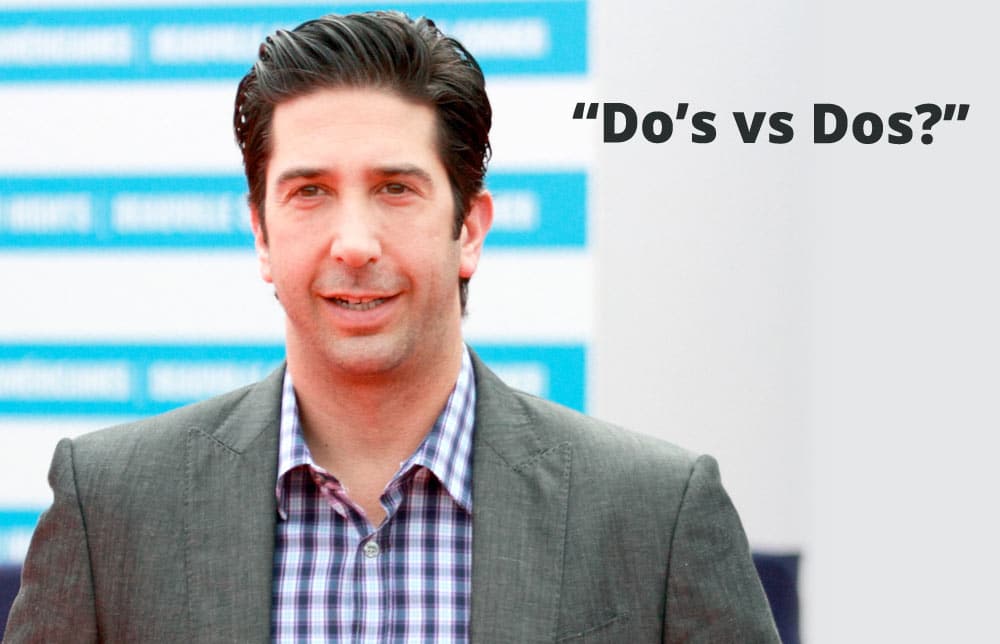Q: Hi guys, can you tell me about “dos and don’ts” – or is it “do’s and don’ts”? Or “do’s and don’t’s”? I’m a little confused, because I’ve seen all of them used at various points.
A: Yeah, it’s a good question. And it comes down to hard rules vs ambiguity.
Q: What do you mean?
A: When you want to write a plural in English, you typically add an “s”, without an apostrophe. An example is you would just say CDs and DVDs, not CD’s and DVD’s. Or 1990s, not 1990’s. No apostrophe required for plurals.
Q: Any exceptions?
A: Well, that’s where things get fun. It comes down to style guides – but it’s widely accepted that you’d put an apostrophe after single letters – simply to stop things getting too awkward.
Q: Like a chaperone on a date?
A: Haha, yes, kind of. So in the phrase “mind your p’s and q’s” you’ll see the apostrophe comes along for the ride. Same with “dot your i’s and cross your t’s” – an apostrophe has no real right to be there, except to add clarity and stop things getting awkward.
Q: My dad once chaperoned me on a date. It was actually extremely awkward.
A: Right. So anyway, in these single letter situations, apostrophes are begrudgingly accepted by most people.
Q: I still can’t believe my dad came with us. He even hugged my date at the end of the night. I may need to see my therapist after this…
A: So that brings us to “dos and don’ts”…
Q: Is that the best version?
A: Well, it’s certainly the one that stays true to the plural rules. However, many style guides including Fairfax and Associated Press opt for “do’s and don’ts”.
Q: Why would you have an apostrophe before the S in the first, but not the second?
A: Exactly. It’s weird. But it comes back to that ambiguity thing again. Having “dos” might confuse for the Spanish for “two” or the DOS operating system. It reads as a rhyme of “Ross”.
Q: You mean like Ross from Friends? He was great. I love Ross.
A: Yes, well if you––
Q: “We were ON A BREAK!” Haha, classic Ross line. Sorry, please continue.
A: Sure. So if you look at “do’s and don’ts”, it doesn’t make a lot of sense.
Q: But, English, right?
A: Precisely. English has odd exceptions from time to time. The other exception often seen is “so-and-so’s” – i.e. “they were a bunch of little so-and-so’s”. Again, that apostrophe isn’t needed but there it is anyway.
Q: So what about the third option: “do’s and don’t’s” ?
A: Well, that seems to be a bridge too far – it’s not nearly as popular as the other two . Perhaps by the time people put a SECOND redundant apostrophe in, the grammar police have been called and the sirens are coming up the street.
Q: Haha, fair enough. So to recap, three versions do exist. If I’m writing for a publication, use their style. Otherwise, use what you like best – for me it’s “dos and don’ts”?
A: Absolutely, just be consistent. We have no problem with the ridicule rule – and using “dos and don’ts” should result in the least amount of ridicule from grammar boffins. Just be aware that “do’s and don’ts” is widely used too.
Q: Final thoughts?
A: You can always aid clarity by capitalising: “Mind your Ps and Qs” or “DOs and DON’Ts” etc. But don’t ever drop the apostrophe in “don’t” – it should never read as “dont”. Never ever.
Q: Good advice.
